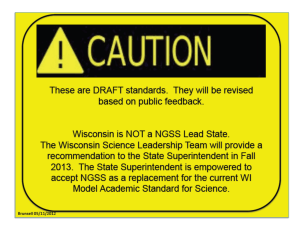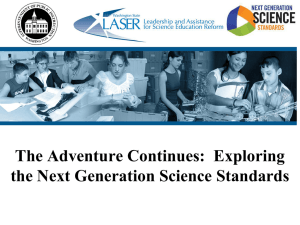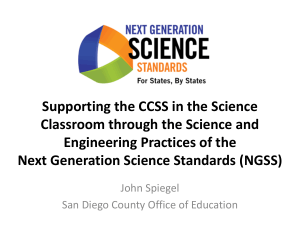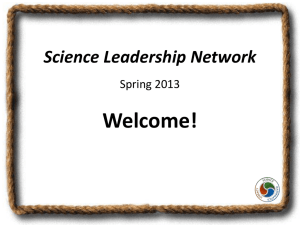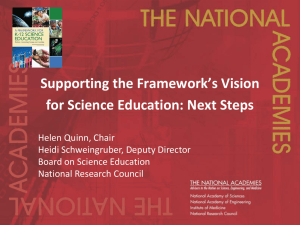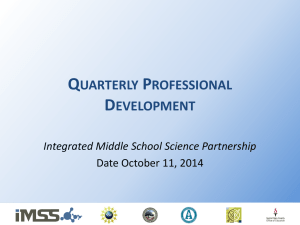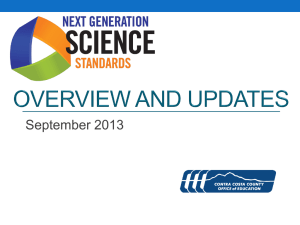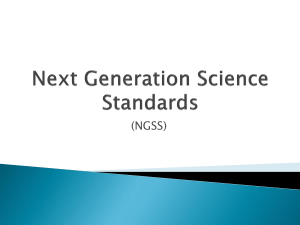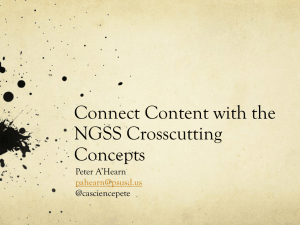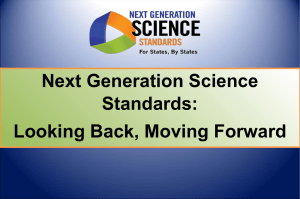RHODE ISLAND LEAGUE OF INNOVATIVE SCHOOLS
advertisement
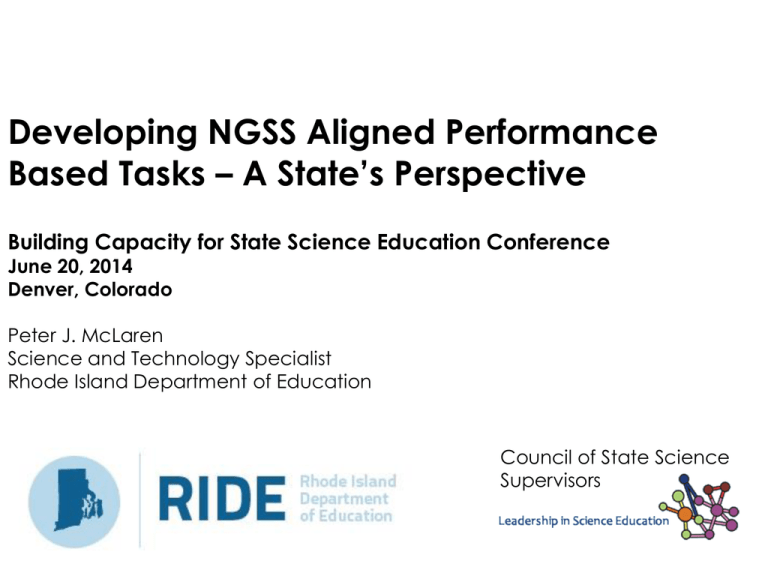
Developing NGSS Aligned Performance Based Tasks – A State’s Perspective Building Capacity for State Science Education Conference June 20, 2014 Denver, Colorado Peter J. McLaren Science and Technology Specialist Rhode Island Department of Education Council of State Science Supervisors New Definition of Competence • The NRC Science Framework & NGSS have proposed descriptions of student competence as being the intersection of knowledge involving: o o o o important science and engineering practices core disciplinary ideas, and crosscutting concepts with performance expectations representing the intersection of the three. • Both the Framework and the NGSS view competence as something that develops over time & increases in sophistication and power as the product of coherent curriculum & instruction 3 WDTFS (What Does the Framework Say) Four key elements of the Framework’s vision that will likely require significant change in most science classrooms 1. A focus on developing students’ understanding of a limited set of core ideas in the disciplines and a set of crosscutting concepts that connects them 2. Emphasis on how the core ideas develop over time as students’ progress through the K-12 system and how students make connection between ideas from different disciplines 3. A definition of learning as engagement in the use of scientific and engineering practices to develop, investigate, and use scientific knowledge; and 4. An assertion that science and engineering learning for all students will require providing the requisite resources and more inclusive and motivating approaches to instruction and assessment, with specific attention to the needs of disadvantaged students 4 Assessment Purposes An Effective Assessment System Should Include a Variety of Types of Internal and External Assessments Internal Assessments • Also known as classroom assessment • Given during or closely following an instructional activity • May include teacher interactions, observations, student products resulting directly from ongoing instruction, quizzes closely tied to instructional activities External Assessments • Designed by districts, states, countries, or international bodies • Used to audit or monitor learning • More distant in time from instruction • May be based upon content and skills defined in state and national standards but they do not reflect the specific content covered in any particular classroom 6 Assessment Purposes • Formative o Occur during course of instruction o Identify students’ strengths and weaknesses o Assist educators in planning subsequent instruction o Assist students in guiding their own learning by evaluating and revisiing their own work o Foster students sense of autonomy and responsibility for their learning Andrade and Cizek, 2010 7 Assessment Purposes • Summative o May be administered at the end of a unit of instruction o Designed to provide evidence of achievement o Used in decision making (assigning grades, promotion or retention, classifying test takers according to defined performance categories such as “basic, “proficient” and “advanced” Andrade and Cizek, 2010 8 Chapter 4 - Developing Assessments for the Next Generation Science Standards 9 Characteristics of NGSS-Aligned Assessments • Measuring the three-dimensional science learning called for in the framework and the NGSS requires assessment tasks that examine students’ performance of scientific and engineering practices in the context of disciplinary core ideas and crosscutting concepts • To adequately cover the three dimensions, assessment tasks will generally need to contain multiple components (e.g.; a set of interrelated questions) • It may be useful to focus on individual practices, core ideas, or crosscutting concepts in the various components of inferences about students’ three-dimensional science learning as described in a given performance expectation • The NGSS require that assessment tasks be designed so that they can accurately locate students along a sequence of progressively more complex understandings of a core idea and successfully more sophisticated applications of practices and crosscutting concepts. (Conclusion 2-2; NRC) 10 Conclusion 4-1 Tasks designed to assess the PEs in the NGSS will need to have the following characteristics: • Multiple components that reflect the connected use of different scientific practices in the context of interconnected disciplinary ideas and crosscutting concepts • Reflect progressive nature of learning by providing information about where students fall on a continuum between expected and ending points in a given unit or grade; and • An interpretive system for evaluating a range of student products that is specific enough to be useful for helping teachers understand the range of student responses and that provides tools to help them decide on the next steps of instruction. 11 Conclusion 4-2 To develop the skills and dispositions to use SEPs needed to further their learning and to solve problems, students need to: 1. 2. 3. Use multiple practices in developing a particular core idea Apply each practice in the context of multiple core ideas Effective use of practices often require that they be used in concert with one another (support explanation with argument, use mathematics with data) 12 Conclusion 4-3 It is possible to design assessment tasks and scoring rubrics that assess three-dimensional science learning • These tasks provide evidence that informs teachers and students of the strengths and weaknesses of a student’s current understanding • The tasks can guide further instruction (formative) and student learning and can also be used to evaluate students’ learning (summative) 13 Conclusion 4-4 Assessments of three-dimensional learning are challenging to design, implement, and properly interpret • Teachers will need extensive professional development to successfully incorporate this type of assessment into their practice 14 What Are We Trying To Do In Rhode Island? 15 Building a Strong Foundation • Designed as a program to respond to the needs expressed around standards-based curriculum, instruction, and assessment statewide • Building a Strong Foundation (BSF) began as the Mathematics Science Partnerships (MSP) Grant with cohorts in mathematics and in science, • expanded through use of Race to the Top funds. • It seeks to increase instructional coherence at all levels of the system by aligning curriculum, instruction, and assessment to each other and to the state standards • 8 districts Project Goal • Develop more rigorous science curricula aligned with challenging Next Generation Science Standards 16 Rhode Island Interim Assessments • The primary purpose of the interim assessments is for instructional planning and monitoring purposes. • developed under the Race to the Top initiative • will enable districts, schools, and teachers to use and create locally managed interim assessments • Item bank of MC, CR, SA and Performance Tasks in grade 3 - 12. • delivered primarily online, • provide rapid turnaround of student results, so that instruction can be changed in real time 17 Overall Performance Task Design – Keep It Simple! • Everything gets built from the standard(s) out • Students participating in the performance task should not see this as an assessment…they should see it as part of their instruction. • One task per grade (3-12) Goals: 1. Provide example of how the NGSS can be assessed threedimensionally 2. Provide a model for development at the state and classroom levels 18 RIIA Performance Tasks 19 Build from the standard out • Select tasks from the Units of Study from BSF work • Identify driving questions from the Unit of Study • Utilize the concepts identified within the driving question of the Unit of Study to build the student PT. • Build task in three parts (formative, formative, summative) • All tasks will have summative assessment as the culminating portion The task as a whole should provide a scaffolding towards the summative with the prior components of the task providing the teacher formative assessment opportunities. 20 Example Modeling Chemical Compounds (7th Grade Performance Task) MS-PS1-1. Develop models to describe the atomic composition of simple molecules and extended structures. [Clarification Statement: Emphasis is on developing models of molecules that vary in complexity. Examples of simple molecules could include ammonia and methanol. Examples of extended structures could include sodium chloride or diamonds. Examples of molecular-level models could include drawings, 3D ball and stick structures, or computer representations showing different molecules with different types of atoms.] [Assessment Boundary: Assessment does not include valence electrons and bonding energy, discussing the ionic nature of subunits of complex structures, or a complete depiction of all individual atoms in a complex molecule or extended structure.] 21 Driving question 1 (from Grade 7 Unit 1 – Structure and Properties of Matter) How can models be used to describe the atomic composition of simple molecules and extended structures? Concepts Substances are made from different types of atoms. - Atoms are the basic units of matter Substances combine with one another in various ways. -Molecules are two or more atoms joined together Atoms form molecules that range in size from two to thousands of atoms. -Molecules can be simple or very complex Solids may be formed from molecules, or they may be extended structures with repeating subunits (e.g., crystals). Solids may be formed from molecules, or they may be extended structures with repeating subunits (e.g., crystals). -Repeating subunits form patterns -Diamonds and sodium chloride are composed of repeating subunits Practices Develop a model of a simple molecule Use model of the simple molecule to describe the atomic composition Develop a model of an extended structure Use model of the extended structure to describe the repeating subunits Task is presented in three parts: • Part 1: Engagement - Students will use the process of evaporation to separate an impure substance (salt water) into its pure components (salt and water). Students will study the atomic structures of the components of salt water by using chemical formulas to construct and sketch their molecular models. • Part 2: Investigation - Student will continue to investigate the molecular structure of other compounds by sketching and making additional models based on their structural formulas. They will examine the process of crystallization by evaporation through the use of a process model to illustrate how salt crystals form and grow. Students will then create a second model that shows how salt crystals can grow. • Part 3: Application: Students will review and analyze the information in Parts 1 and 2 to construct an explanation for the 23 following question: Teacher Guidance Document • The goal of the TG is to provide guidance for the teacher but not a scripted approach. • We want support the teacher in the task administration but not limit their natural interaction in terms of instruction with students. 24 Table of Contents Introduction XX Overview XX Background from the Framework for K-12 Science Education (Framework) and the Next Generation Science Standards (NGSS): (i) Framework: XX (a) Disciplinary Core Idea XX (b) Progression for Practice XX (c) Crosscutting Concepts XX (ii) Targeted Next Generation Science Standards: Performance Expectations XX (iii) Common Core State Standards Connections XX (vi) Associated K-12 NECAP Assessment Target XX The Performance Task: (i) Task Description (ii) Time Allotment (iii) Key Vocabulary XX XX XX Teacher Guidance in Task Administration: (i) Part 1: Engagement (ii) Part 2: Investigation XX XX Appendix A: Scoring Guides Appendix B: Word Bank Appendix C: Comprehensive Task Materials Checklist XX XX XX Appendices: Teacher Guidance Document • TG is basically be a copy of the student PT but in a separate cell the pertinent guidance at each stage of the PT. • For every PT the TG would have: o background from the framework o DCI progressions, SEPs, CCCs, and PEs as standard opening pages within each TG. o TG for the PT as a two-celled document with the student PT detailed the left column as the student would see it and in the right column have correlated and direct guidance for the teacher (as shown in the example above). 26 Teacher Guidance Document What the Students Will Do In this area will be the student PT This would be copy and paste of what the student “sees” in their performance task What the Teacher Will Do In this area the teacher guidance to implement the student PT is noted side-by-side so the teacher will have an awareness of: Formative question probes to administer Prompts to distribute materials (i.e. worksheets, equipment, etc.) Suggestions of what to look for in terms of student understanding and/or misconceptions Note: The summative component of the task would have rubrics for the teacher to score the student work with exemplars. 27 Let’s Look At The Task 28 Lessons Learned from our Experience • Do not assume that assessment developers understand the NGSS • Designing a performance task is a very time consuming process • Never forget your experience as a teacher • Considerations for equity (materials, access, etc.) • Allow freedom for teacher innovation 29 Discussion 31 Resources and Contact • Building A Strong Foundation o http://www.ride.ri.gov/InstructionAssessment/InstructionalReso urces/BuildingaStrongFoundation.aspx • Charles A. Dana Center o http://www.utdanacenter.org/ o User: Rhode o Pass: Island • Peter McLaren o Peter.mclaren@ride.ri.gov o 401-222-8454 32

